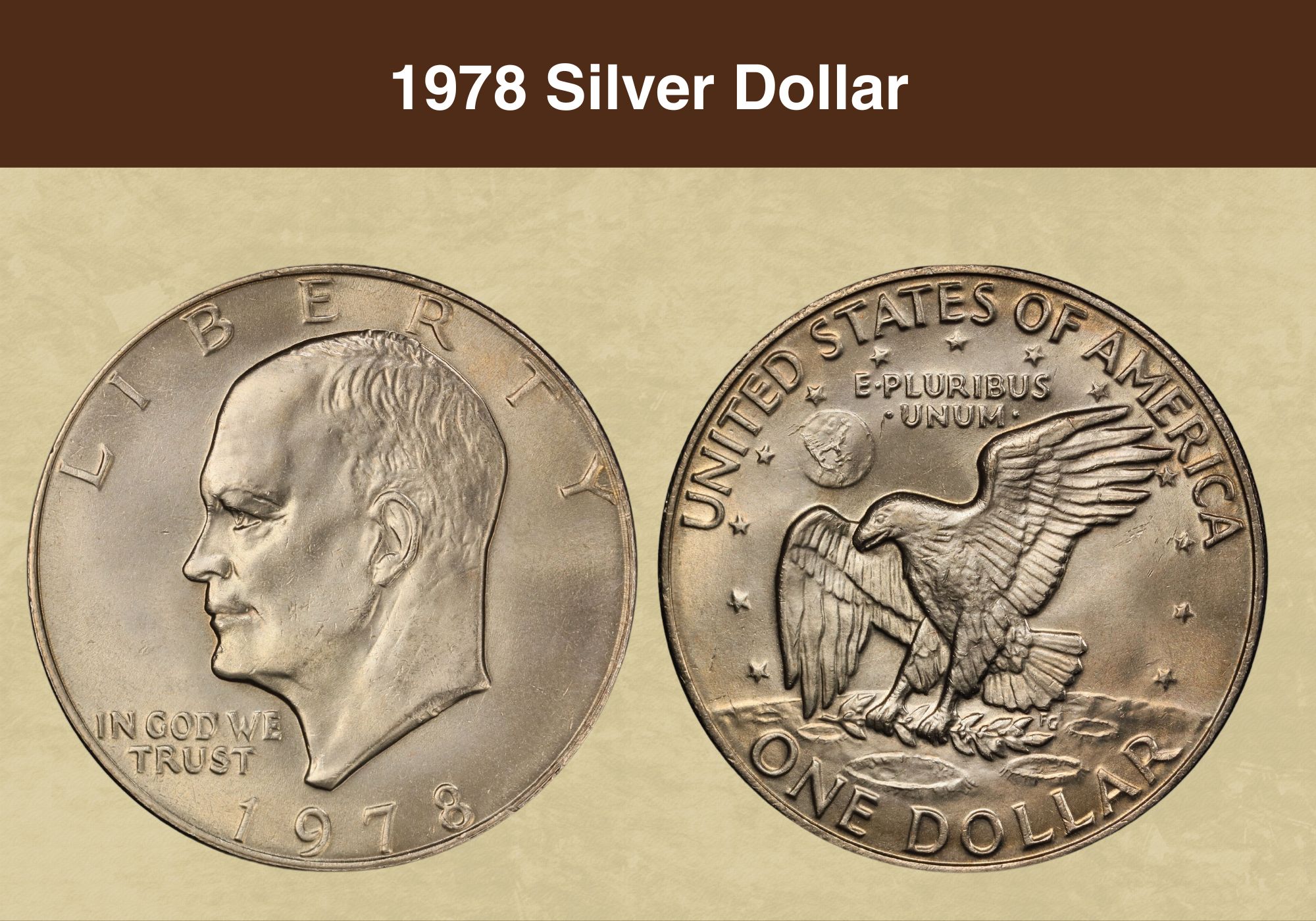
Coin Value Contents Table
- 1978 Silver Dollar Value Chart
- History of the 1978 Silver Dollar
- Features of the 1978 Silver Dollar
- 1978 Silver Dollar Value Guide
- 1978 No Mint Mark Silver Dollar Value
- 1978 D Silver Dollar Value
- 1978 S Proof Silver Dollar Value
- 1978 Silver Dollar Grading
- Rare 1978 Silver Dollar Error List
- Where to Sell Your 1978 silver dollar ?
- FAQs
Have you got a 1978 dollar that’s silver in color? Wondering if it could be valuable? Well, you’ve come to the right place to find out!
We’re going to look at the 1978 silver dollar value. We’ll find out about the different factors that influence it. And we’ll learn more about the design and history of this coin as we go.
Ready to find out how much your dollar coin is really worth? Then let’s get started!
1978 Silver Dollar Value Chart |
||||
| Mint mark | XF45 | MS60 | MS65 | MS67 |
| 1978 (P) No Mint Mark Dollar Value | $1 | $5 | $32 | $7,500 |
| 1978 D Dollar Value | $1 | $5 | $45 | $9,500 |
| PR60 | PR65 | PR68 | PR70 | |
| 1978 S Proof Dollar Value | $1 | Deep Cameo: $6 | Deep Cameo: $14 | Deep Cameo: $475 |
History of the 1978 Silver Dollar
First things first: the 1978 “silver” dollar isn’t actually silver at all. Dollar coins were made with real silver in a number of years, but not in 1978. The silver color comes from the cladding, made of an alloy of copper and nickel. And the core of the coin is pure copper.
It’s one of the series known as the Eisenhower dollars, after the image of the former president which appears on the obverse. The first Eisenhower dollars were struck in 1971, and 1978 marked the final year in which they were issued.
Eisenhower had died in March 1969, and many people felt he should be honored with a coin. But there was considerable controversy over whether or not the new coin should be made of silver.
The price of silver was rising at the time, so a silver coin would be more expensive to produce. But some people felt that using a base metal would be disrespectful to Eisenhower’s memory.
The first Eisenhower dollars were therefore a compromise. Most were made of copper clad in cupronickel, but a small number were made from a silver alloy.
The dollars struck in 1975 and 1976 were special issues, with a new reverse to mark the bicentenary of American independence. The majority were again copper clad in cupronickel, with a smaller mintage of silver alloy coins.
But from 1977 onwards, only clad Eisenhower dollars were struck. The silver coins were expensive to make. And the large size and weight of both versions meant that they were unpopular for everyday use.
The Mint began to experiment with smaller dollar coins. And finally, in 1979, the Eisenhower dollar was replaced with the smaller Susan B. Anthony dollar.
Also read: 12 Most Valuable One-Dollar Coin Worth Money
Features of the 1978 Silver Dollar
The Obverse of the 1978 Silver Dollar
The obverse of all the Eisenhower dollars bore a portrait of the former president, Dwight D. Eisenhower.
It was the work of the US Mint’s Chief Engraver at the time, Frank Gasparro, and was based on a sketch made almost 30 years earlier. Gasparro had caught sight of the then General Eisenhower at a parade marking victory in the Second World War.
Only Eisenhower’s head and neck are shown in the image. He appears in profile, facing left, and wears rather a stern expression. Some commentators at the time felt that was at odds with his genial personality.
The word “LIBERTY” is inscribed above his image, arching to follow the curve of the upper coin edge. The motto “IN GOD WE TRUST” appears to the left as the coin is viewed. The date is at the bottom.
Depending on where the coin was struck, it may also have a mint mark. Dollars struck in Philadelphia don’t have one. But those made in San Francisco are marked with an “S”, and those in Denver with a “D”. Look for the mint mark just above the “7” of the date.
The Reverse of the 1978 Silver Dollar
After the completion of the bicententary celebrations, 1977 saw a return to the original Eisenhower dollar reverse.
This had been based on a patch commemorating the Apollo 11 mission, designed by the astronaut Michael Collins and others. It showed an eagle landing on the moon, a sprig of olive clutched in its talons. Above it, part of the earth is visible in the distance.
The eagle is ringed by stars, representing the states. The country name curves along the top edge of the coin, while the denomination mirrors it at the bottom. The Latin motto “E PLURIBUS UNUM”, meaning “From the many, one” is inscribed over two horizontal lines immediately above the bird.
Other Features of the 1978 Silver Dollar
Although it appears silver, the 1978 dollar is copper clad in cupronickel. The silver color comes from the nickel in the cladding.
The coin measures 38.5 millimeters in diameter, the same as silver dollars, but is slightly lighter. Clad dollars weigh 22.7 grams, compared to 24.6 grams for the silver versions.
Turn the coin on its side, and you’ll see a series of grooves around the edge. These are known as “reeds” and were first used in the eighteenth century to prevent a practice known as “coin clipping”. This was when precious metal was sliced from the edges of coins, reducing their value.
This YouTube video from BigDCoins takes a look at examples of 1978 dollars from Philadelphia, Denver, and San Francisco.
Also read: 14 Most Valuable Coins In Circulation
1978 Silver Dollar Value Guide
1978 No Mint Mark Silver Dollar Value
If your 1978 dollar coin has no sign of a mint mark, it was made in Philadelphia. The Mint facility there struck over 25 million dollar coins that year. So even in very good condition, most won’t be worth more than their face value.
To get a better idea of the value of an individual coin, though, you need to be able to grade its condition. Coins are graded on a scale from 1 to 70, with 1 being the lowest and 70 the highest.
At the upper end of the scale, even a difference of one point can make a huge difference to the value of a coin.
If your coin hasn’t already been graded, the easiest way to find out its condition is to have it assessed. Reputable independent agencies like the PCGS, NGC or ANACS will do this for you – but you’ll have to pay a fee. So it’s only worth doing if you think your coin could be really valuable.
Otherwise, there are lots of videos online that can help you determine the grade of your coin.
A 1978 no mint mark dollar graded XF45 – the letters stand for “extremely fine” – will only be worth its face value.
Mint state coins – those that have never been circulated – are more valuable. But even many of those can be purchased for a modest amount.
A 1978 Philadelphia dollar graded MS60, the lowest mint state grade, is worth around $5. And at MS65, the lowest level at which a coin is classified as a “gem”, the value is around $32.
Availability declines beyond that level, and prices rise accordingly. A dollar graded MS66 is worth around $160, climbing to $750 at MS66+.
And the finest known examples are graded MS67. The PCGS has certified twelve coins at that grade, and values them at $7,500 each.
1978 D Silver Dollar Value
The Denver Mint facility was the most prolific in striking dollar coins in 1978. Over 33 million came out of the coin presses there. You can identify them by the small “D” on the obverse, just above the date.
Values mirror the Philadelphia coins at lower grades. Circulated coins are worth only their face value, while a dollar graded MS60 is worth around $5.
But gem coins are rarer and more valuable. A 1978 Denver dollar graded MS65 is worth about $45, $13 more than the Philly equivalent. The value rises to $225 at MS66, before returning to the same level as a Philadelphia dollar at MS66+ ($750).
Quality again tops out at MS67, but only nine Denver dollars have been certified at that level by the PCGS. As a result, they carry a hefty premium, and are valued at $9,500 apiece.
1978 S Proof Silver Dollar Value
The 1978 S silver dollar is a proof coin, one made by striking a highly polished planchet with specially prepared dies.
Proofs were aimed at the collecting market, and in earlier years both clad and silver proof dollars had been struck. But in 1978, just as with the business strike coins, all proof dollars had copper cores clad in cupronickel.
The San Francisco Mint facility struck over 3 million proof dollars in 1978. So while the numbers were lower than the business strike coins, there are still plenty of them around. And because they were marketed as collectors’ items, most have been kept in good condition.
As a result, while these coins might be attractive, most are worth only their face value. For a proof 1978 S dollar to be worth more than that, it needs to be in exceptional condition.
Some proofs have an attractive contrast between frosting on the raised parts of the design and reflective flat areas. Coin grading agencies designate coins like this as “cameos” or, if the contrast is particularly dramatic, “deep cameos”. Both designations make a coin more valuable.
1978 San Francisco deep cameo dollars can be found in grades from PR65 upwards. But even these can be purchased at surprisingly low prices.
A proof graded PR65 deep cameo is worth around $14, while one at PR68 has a value about a third higher. And even a perfect PR70 deep cameo, the highest possible grade for a proof coin, can be yours for around $475.
Also read: Top 10 Most Valuable Morgan Silver Dollar Worth Money
1978 Silver Dollar Grading
Rare 1978 Silver Dollar Error List
1978 (P) No Mint Mark Dollar, Struck on Defective Planchet
One dollar that came out of the Philadelphia Mint facility in 1978 was struck on a defective planchet. The cladding had not bonded properly to the metal strip, with the result that most of the obverse had a copper tone. A large part of the detail had also been lost on Eisenhower’s portrait.
The coin was graded MS63 by the PCGS. A coin at this grade without the error would have been worth around $24. But this one sold at auction for over $700.
1978 (P) No Mint Mark Dollar, 10 Per Cent Brockage
A brockage error occurs when a coin that has already been struck sticks to the die. Then, when the die strikes the next planchet, it impresses a mirror image of the stuck coin onto the metal.
That’s what happened with another 1978 dollar struck in Philadelphia. In this case, only part of the struck coin was pressed into the new planchet. About 10 per cent of the error coin bore its imprint.
It was graded MS64 by the PCGS, and sold at auction for $745.
Where to Sell Your 1978 silver dollar ?
Now that you know the value of your coins, do you know where to sell those coins online easily? Don’t worry, I’ve compiled a list of these sites, including their introduction, pros, and cons.
Check out now: Best Places To Sell Coins Online (Pros & Cons)
FAQs
Is a 1978 silver dollar real silver?
No. The silver color in a 1978 dollar comes from the cladding. That’s a mixture of copper and nickel, and it’s the nickel that gives it the silver tone. The core of the coin is made from pure copper.
From 1971 until 1976, some Eisenhower dollars were made with real silver. The easiest way to tell whether a coin from this period is silver or clad is to weigh it. Silver coins are heavier than clad ones, weighing 24.6 grams compared to 22.7 grams.
If you don’t have accurate enough weighing scales for the job, a visual inspection may be all you need.
Look closely at the edge of the coin. If it’s clad, you may be able to see signs of the copper core where the cladding has worn away. If the coin is uncirculated, however, the copper may not be visible.
How rare is a 1978 dollar coin?
Tens of millions of dollar coins were minted in 1978, so a standard coin isn’t rare. But if you have a coin in top condition, or one with an interesting error, it will be much rarer. And that means collectors will be prepared to pay more to own it.
The best-in-class examples of Philadephia and Denver 1978 dollars are worth thousands of dollars. And a perfect San Francisco deep cameo proof is worth around $500.

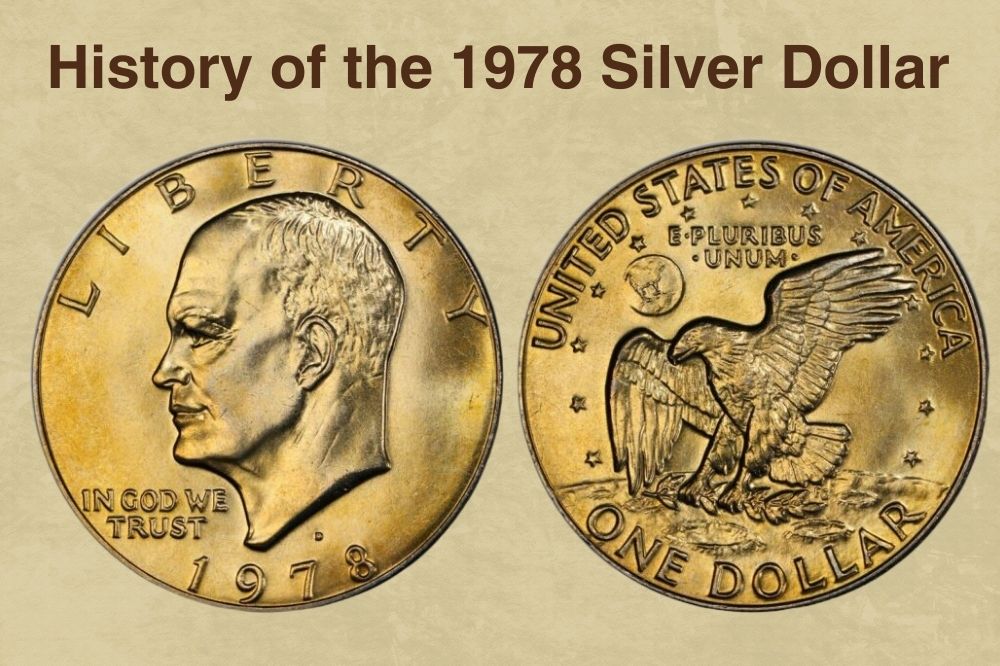
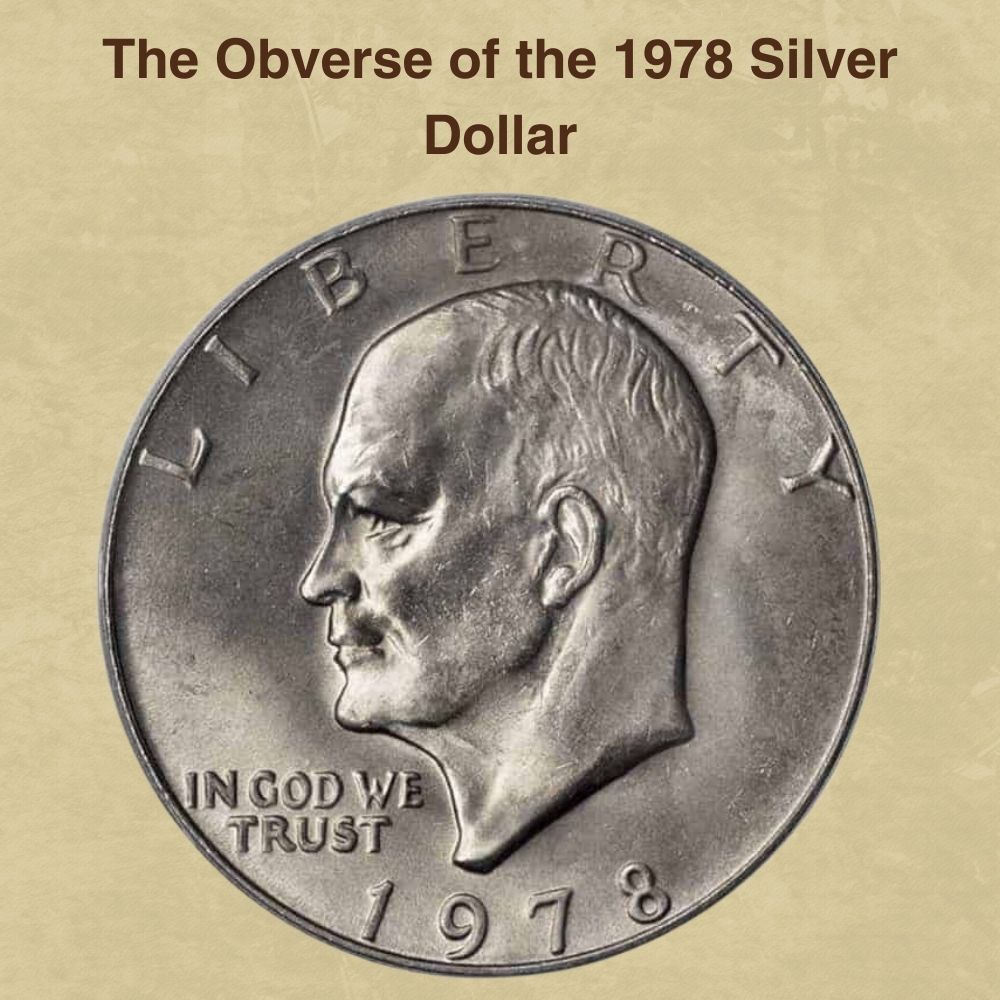
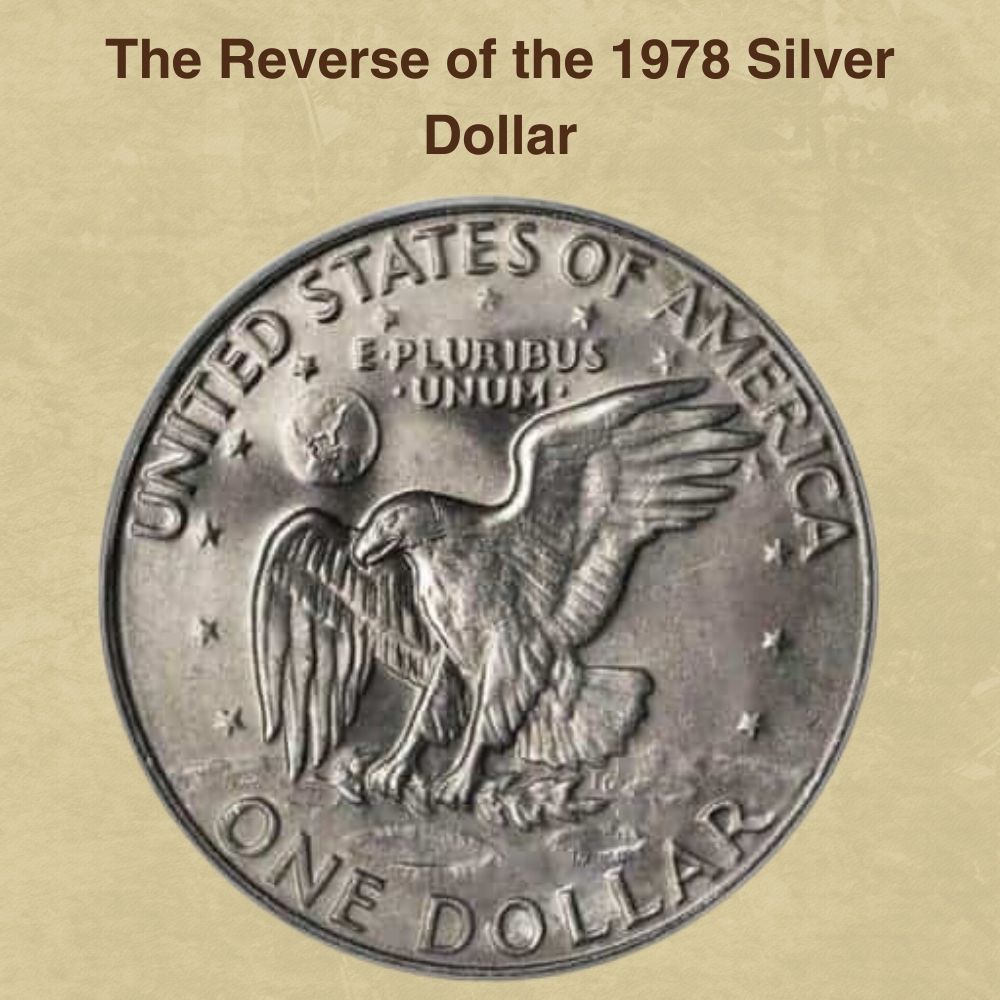
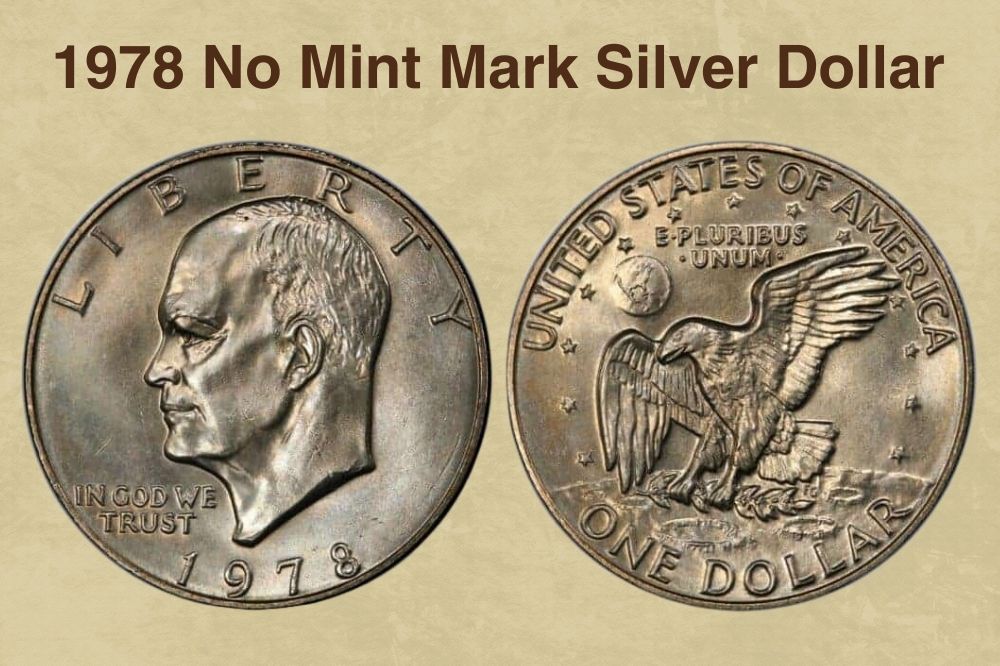
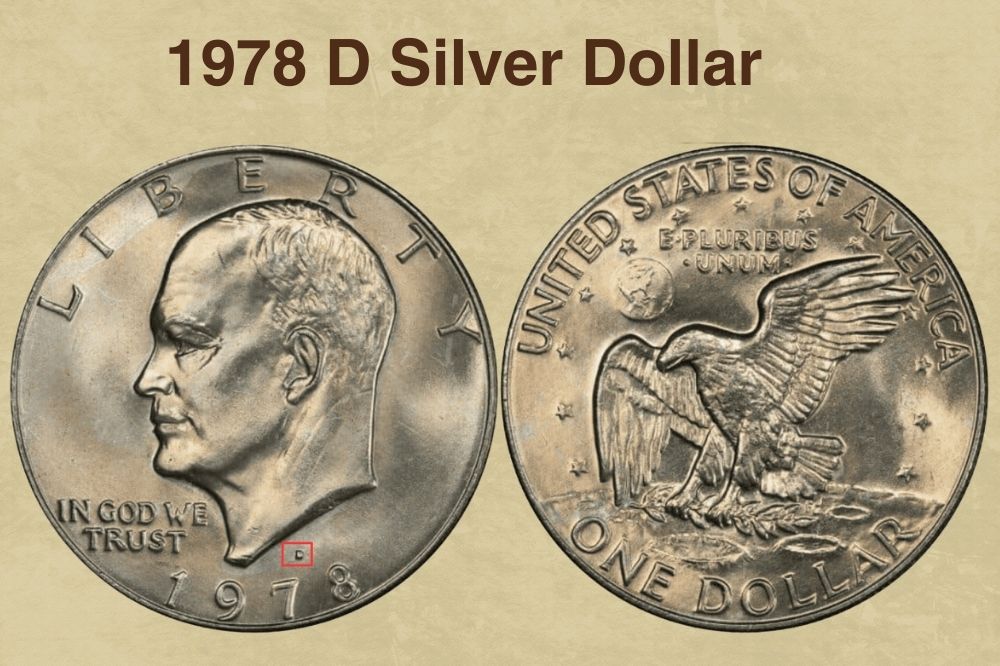
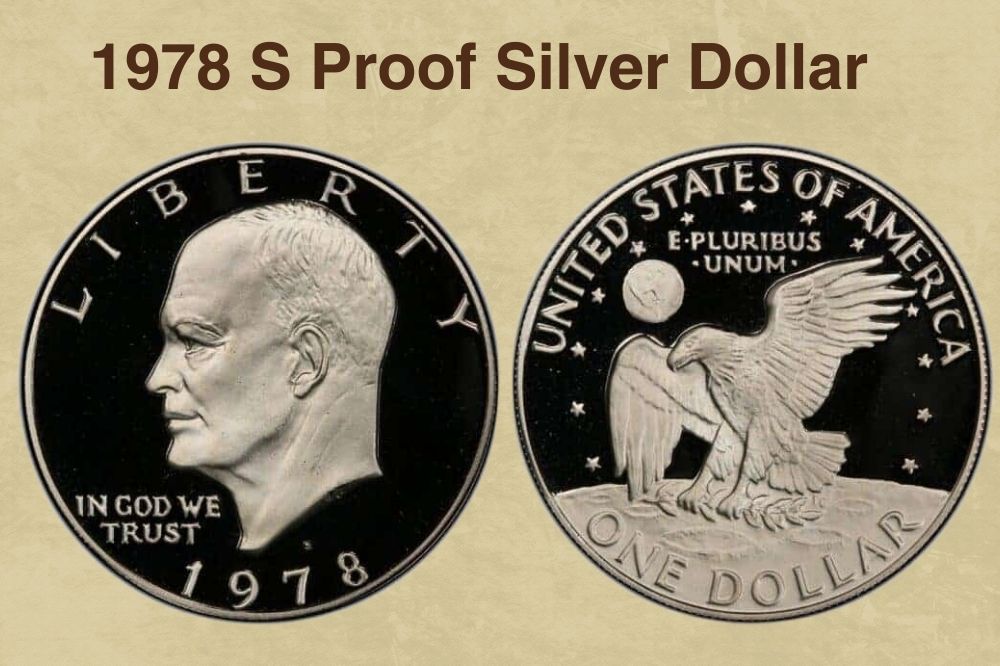
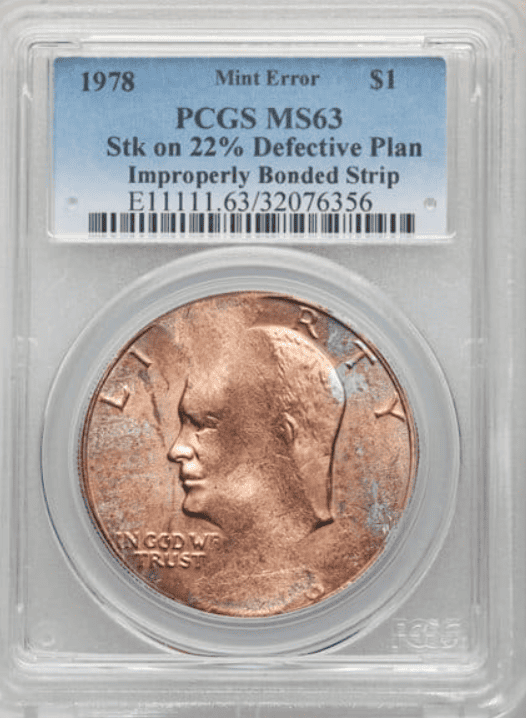
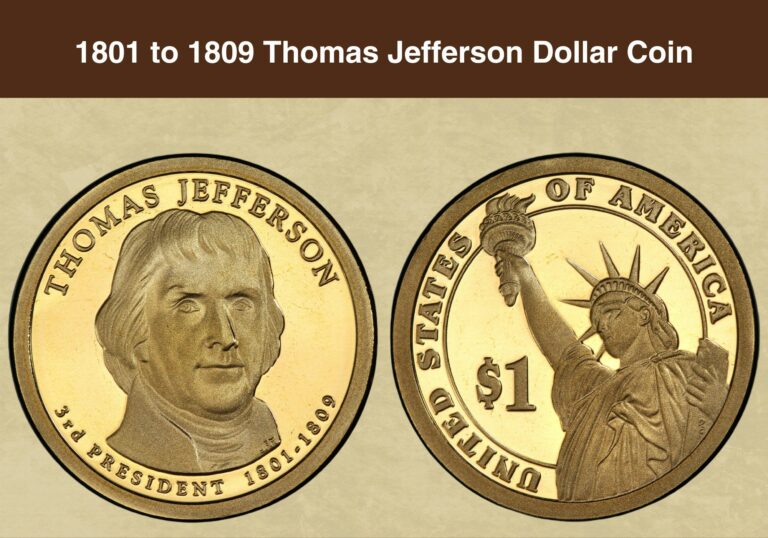
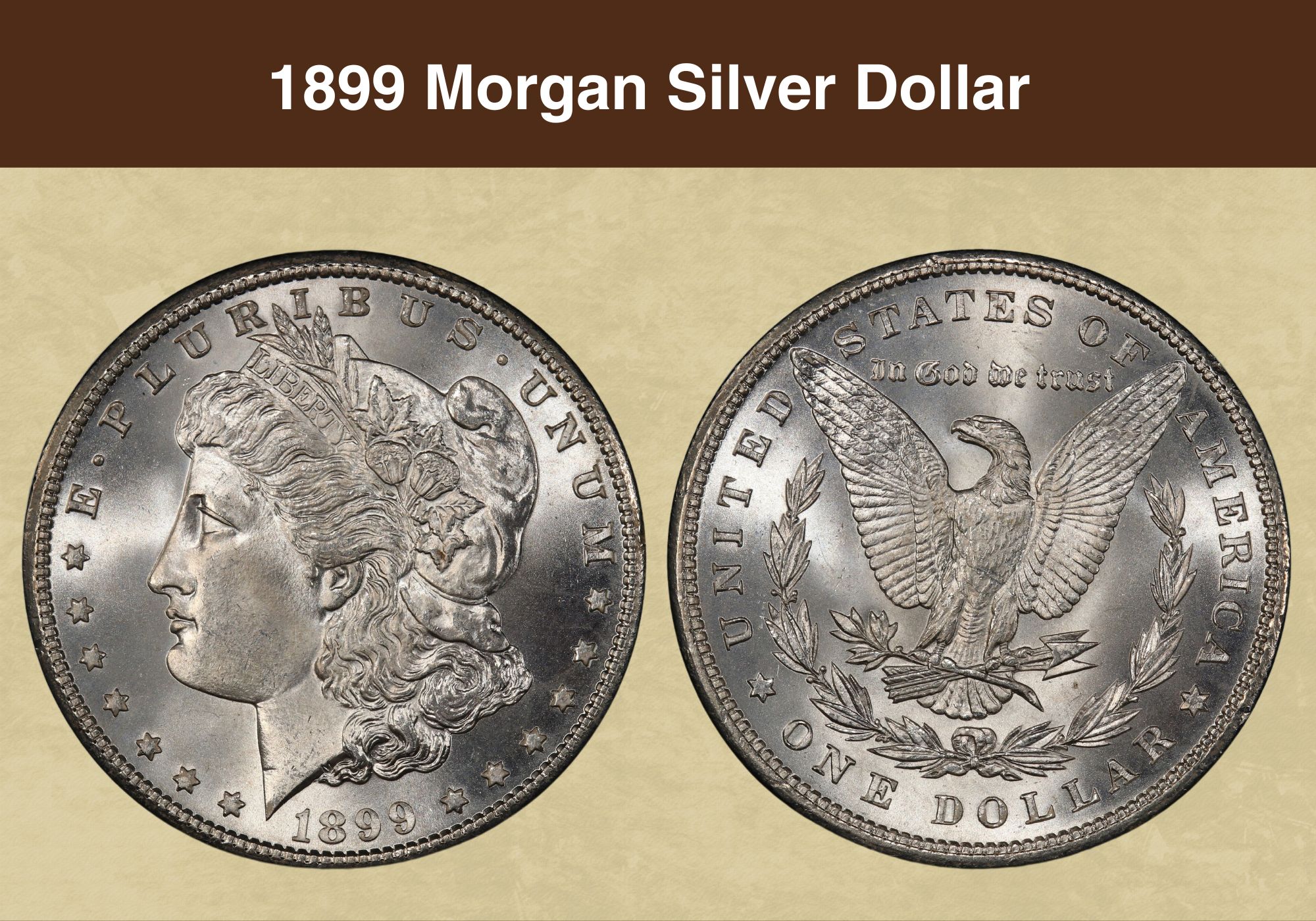
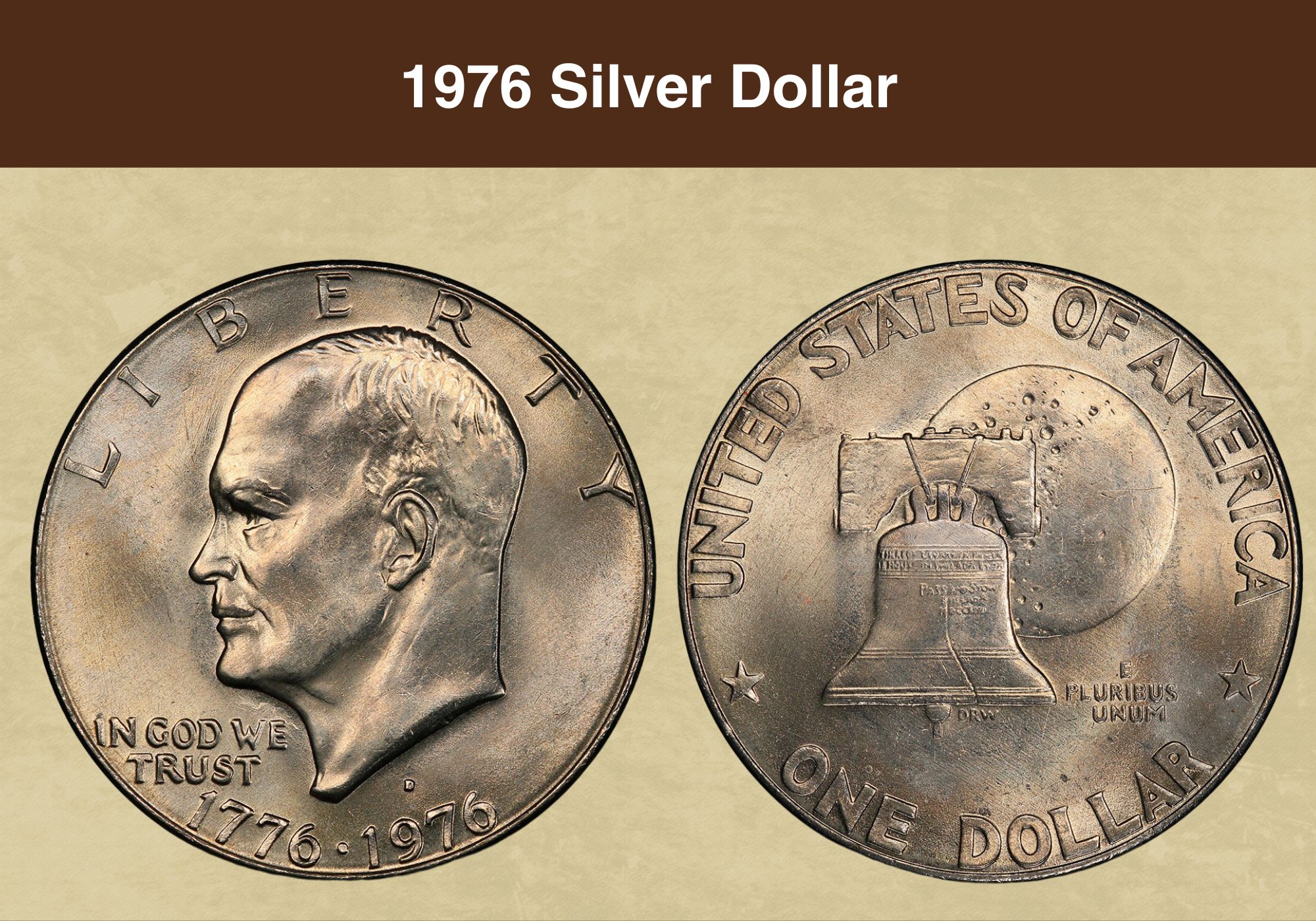
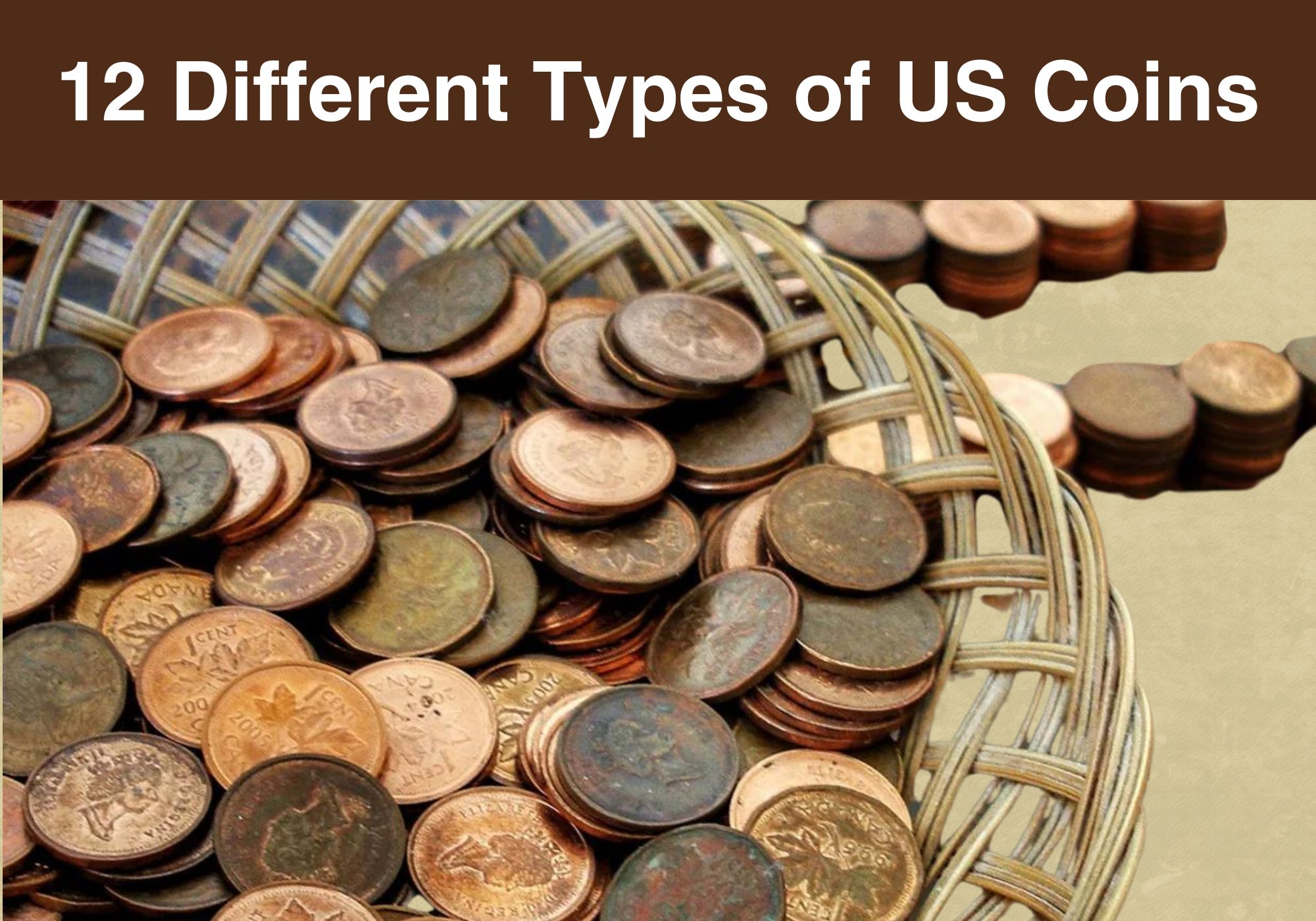
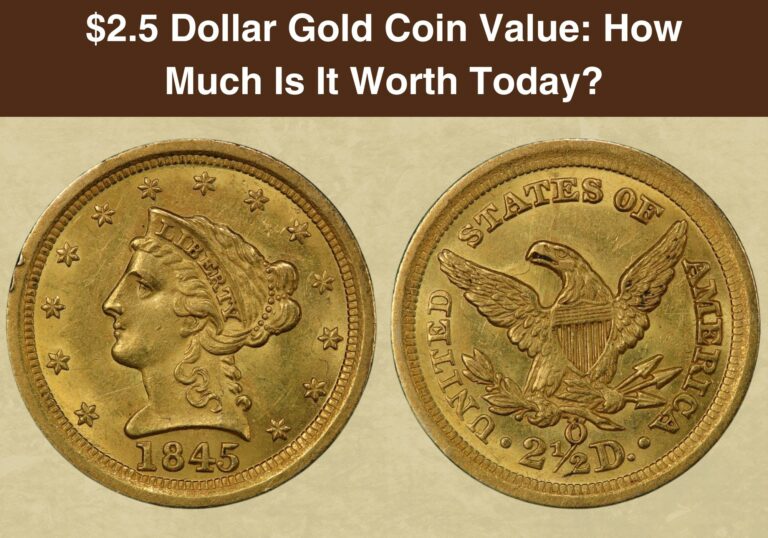
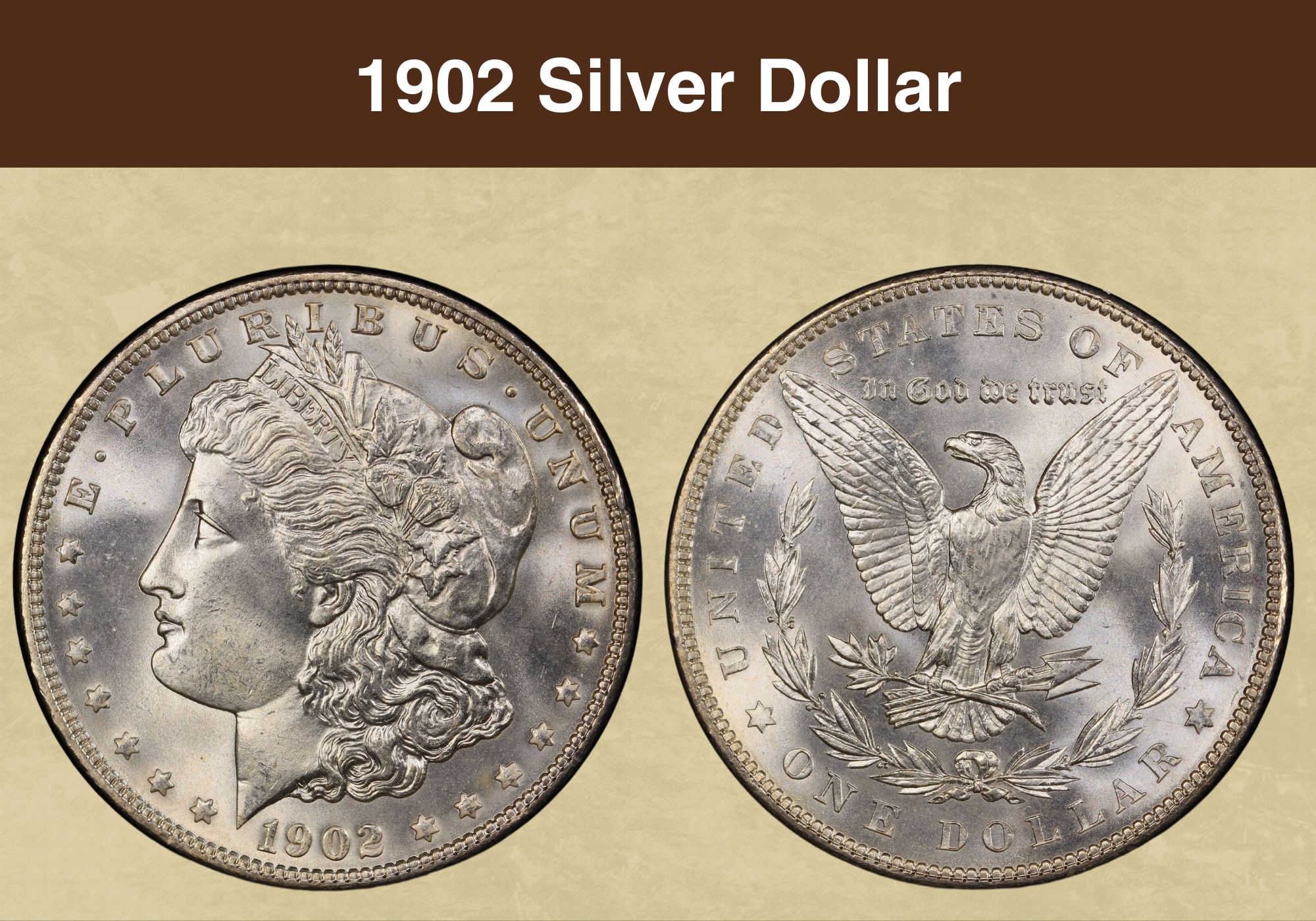
I am looking for a way to sell my coins and I have a lot of them that are there I want to be in an auction. To get the most money possible for my coins because a coin collector is not going to give me their worst because he’s going to look at it I have to make a profit so if you are a coin collector I am not interested in anything that you have to say I’m only interested in people that’s running an auction pray and I am not interested in a scammer
Go buy some gum balls with your coins. Nobody in the industry will have anything to do with you after reading your request.
Good Morning John Saechao I have a few coins that I need someone to look at and give me the true value for sale. Thank you